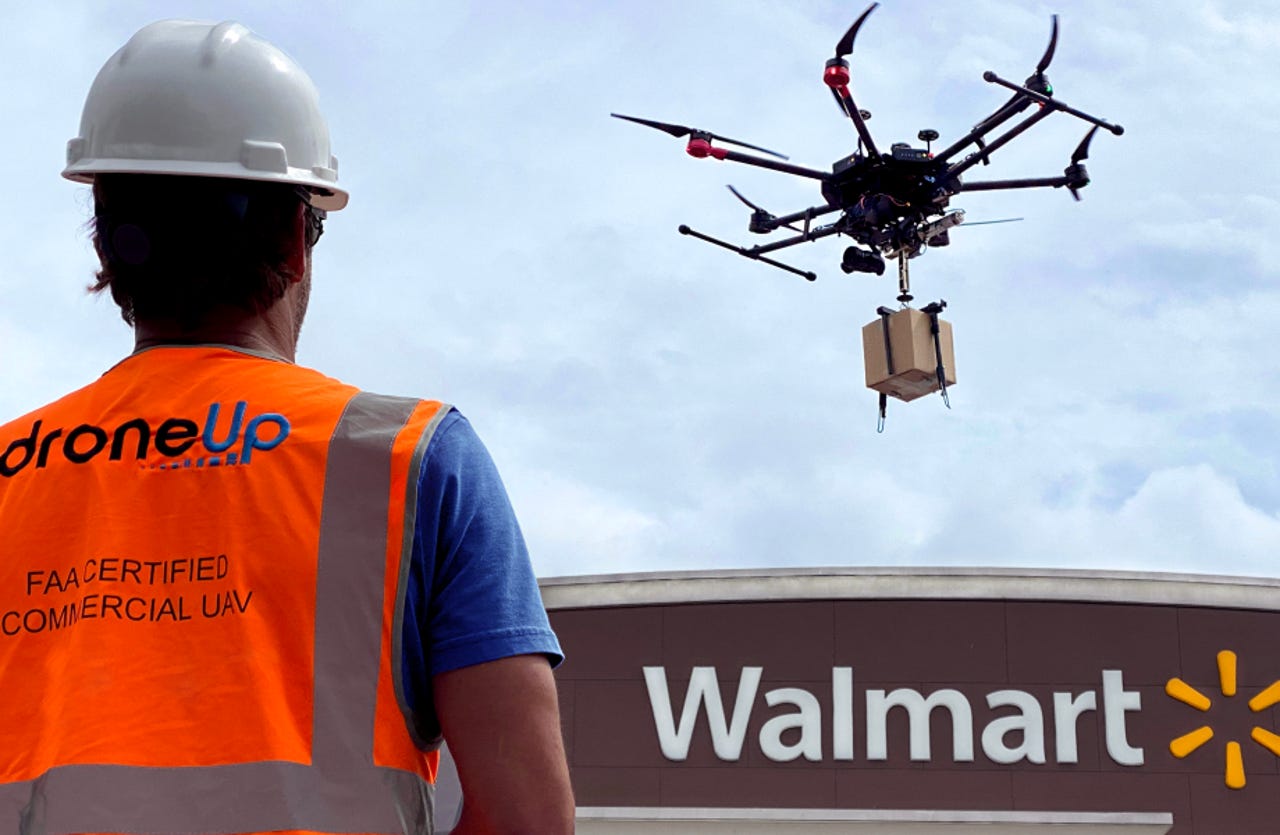































 DroneUp
DroneUp Swinging back against the Bezos behemoth and searching for every advantage in an increasingly digital world, Walmart is looking to the skies. Drone delivery is coming, and Walmart is using its vast geographical footprint in a modern game of retail Risk.
As the FAA increasingly embraces commercial drone operations, drone delivery in the United States is closer than ever to reality. In concert with company DroneUp, Walmart has rolled out the first of its drone "Hubs," which are co-located with Walmart stores. Walmarts have 90 percent of the U.S. population within 10 miles of their stores, and each store is optimized for that particular area's audience.
Walmart invested in DroneUp last June, signaling the retailer's commitment to drone services for the long haul.
This isn't just about retail. In a bid to integrate Hubs with the local communities they serve, drone services are also being delivered, including community resources for law enforcement, insurance inspections, infrastructure inspections, and other use cases that businesses in those areas need from a drone.
This is a big move for Walmart and a coup for DroneUp, which has been expanding its drone services offerings.
"First, you have to understand the role of the Hub and why positioning those relative to Walmarts is so valuable," Tom Walker, DroneUp's CEO, told me recently. "The goal is to be able to successfully deliver products that people want store-to-door consistently, and in order to do that, it's important to have access to an inventory of products that are readily and consistently available despite supply chain issues."
Here's where Walmart's baked-in regional fluency is a big advantage. Walmart stocks in-market products for the audience in and around the Hub locations. Positioning these Hubs next to Walmarts gives DroneUp direct access to tens of thousands of SKUs that are specifically designed for the demographic audience in and around that location.
"After the order is made," said Walker, "the product is brought from the store to the Hub, loaded onto the drone then flown in an optimized route to the home. We deliver goods from as low as 80 feet to as high as 100 feet, and gently set the product on the ground at the customer's location. We are doing that consistently today in under 30 minutes from the time the product(s) is ordered until the product is at the customer's home."
One of the interesting subplots here is that there's not much of a labor force for a commercial drone sector, and the challenges of creating one from scratch are profound in a historically tight labor market. DroneUp has launched a job training initiative where they fly new employees into one of their hubs for training on the drones, the delivery operations, and how to maintain the drones themselves. It's a compelling illustration of what the industry has been promising for years: jobs, delivery, services, and safety.
"We believe that one of the key components to being able to scale these operations is talent," says Walker. "We invested specifically into our recruiting engine to bring on the right people. We understand that not only is recruitment important, but retention is important, too. Turnover can create challenges when you're trying to scale operations as quickly as we are. So we are investing significantly into training programs. We're actually building a facility right now in Virginia where we'll be able to bring the operators in for training. There'll be a couple of weeks of online training, and then a couple of weeks of in-person training covering around-the-clock data, daylight operations, nighttime operations, different ways of dealing with potential issues that arise, and more, and then they'll go out in the field."
Underscoring all this is an evolution in the FAA's view of beyond visual line of sight (BVLOS) flying.
"We're excited about the FAA leaning into this and recognizing that in order for this industry to scale, we're going to have to fly beyond the visual line of sight. One of the challenges has always been that we've held the unmanned systems world to the same level of safety [standards] that we've held the manned aviation community, and that's a very difficult thing to do in terms of where and how we're operating."
Walker points out that the recent FAA Aviation Rulemaking Committee (ARC) recommendations were very specific when it comes to risk: how do we appropriately manage and measure risk to enable us to go beyond our visual line of sight?
"The important thing I say to the community is we don't need to immediately go from visual line of sight to unlimited BVLOS. We need to make incremental changes. How can we go from here to a little bit further, then a bit further than that, and maintain safety while determining an acceptable level of risk? Does it have to be equivalent to standard general aviation rules that are carrying personnel and so forth?"
Last November the companies announced plans to open three drone Hubs at Arkansas Walmarts, with more locations pending.
 Etiquetas calientes:
innovación
transporte
Etiquetas calientes:
innovación
transporte